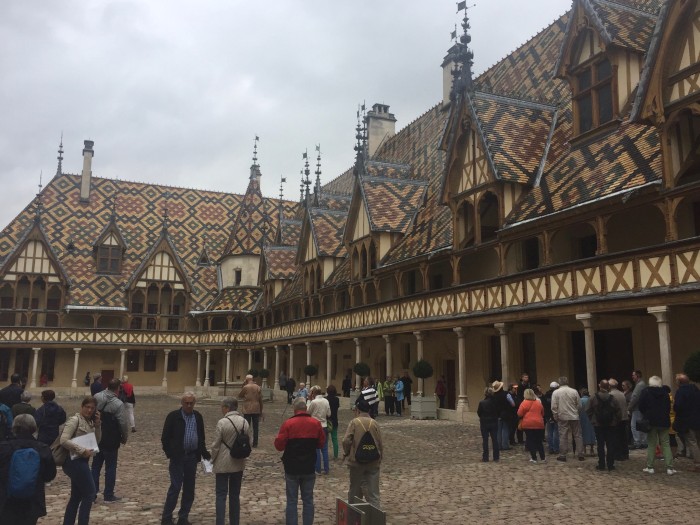Ancient Town of Beaune
26 October 2019
by Terry Spencer

After attempting to reset our circadian rhythm, Elisa and I headed out to explore the town. Humans lived in the valley in prehistory. During Roman times, the valley was used for cattle and viticulture, which continues to this day. Up through the fifteenth century, the area was ruled by the Duke of Burgundy. The Chancellor of the last Duke, Charles the Bold, founded the Hospices de Beaune, a charity hospital. Its beautiful tile roof is worth admiring, so we did. Then we toured the Hospice where one can see what the old ward, chapel and ancient apothecary looked like.
We also visited the caves belonging to Patriarche et Fils, wine merchants. Walking a half kilometer underneath Beaune, we viewed thousands of bottles of wine stored in the constant temperature underground. At the end, there was a tasting. We were not impressed by flavor of most of their wines. We were beginning to despair, as we were in the wine capital of France, but had not yet tasted good wine.
The next day was much more promising. We went off to rent eBikes and headed south out of town through vineyards and small villages. The temperature was perfect for a ride on a partly cloudy day. The vineyards were verdant with late summer foliage and the harvest season was just beginning. This meant that there was occasional vintner traffic on the bike path, but we also were able to see some harvesting going on.
Vines were crowded together, and although there was an occasional sign marking a particular domaine, only the vineyard owners knew where their holdings began and ended. This obscures that there are precisely delineated vine plots known as ”climats”, each with its own microclimate and specific geological conditions partly shaped by human cultivation over the centuries. This is of course what people are talking about when they discuss “terroir”. We were told that there are around 1400 of these climats in the valley, their quality ranging from Appellations Grand Cru through Premiere Cru and Villages, to Appellations Regionales. The appellations are described by region (Bourgogne), town (Puligny-Montrachet), and domaine (Domaine Pascal) and then include the quality designation. I now understood my confusion when trying to read a French wine label in an American grocery store.
So we biked southward through the villages of Pommard, Volnay, Meursault, and Puligny-Montrachet, names you may have seen on the aforementioned wine labels. The villages were several kilometers apart so that you could often see the next one in the distance across the vineyards as you biked. The villages themselves were absolutely charming. Likely they had not changed much in centuries. At an intersection in one, we saw a testament to the small batch wine making of the region. A mobile bottling truck was parked on the street, filling bottles as workers stacked them in bins for storage, probably in local caves.
We lunched in Puligny-Montrachet and sipped a wine by the same name and one from Meursault. They were delightful. Although I could have taken a nap at that point we began to pedal back to Beaune. After returning the bikes we went to a Brasserie in town and sipped two local Premiere Cru reds that were excellent.
Before leaving Beaune the next day, we walked off our breakfast on the ramparts of the old city walls. We passed a tower that had been built during the Thirty Years War. Everywhere we turned there was incredible old architecture and preservation of this culture and beauty. It was extraordinary.
And then we caught a TER train to Laroche-Migennes for the next part of our adventure.



Comments